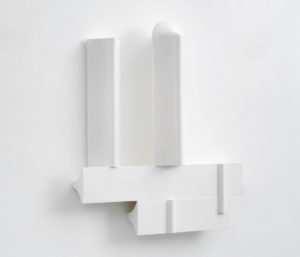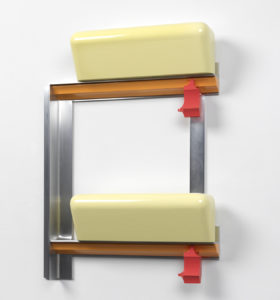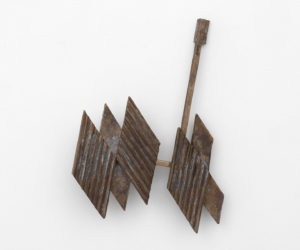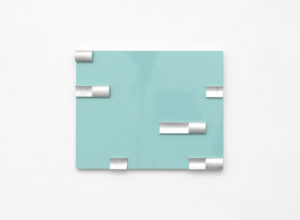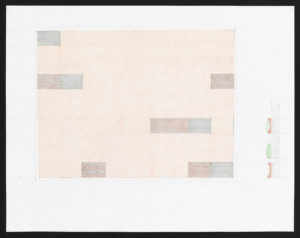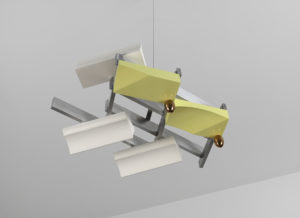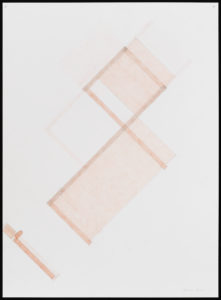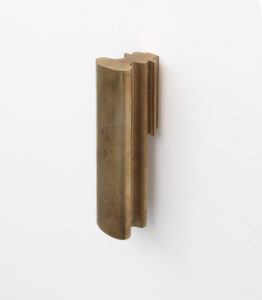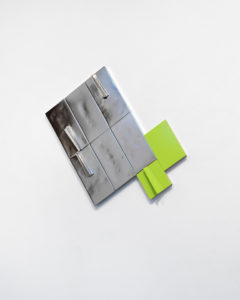January 2, 2025—February 22, 2025 | Reception Saturday, January 11th, 4-6PM
James Harris Gallery is pleased to present the seventh solo exhibition by Chicago artist Richard Rezac and his first in Dallas. Titled “Abridged”, the show consists of a grouping of seven sculptures and three drawings created over the past thirteen years. The exhibition gives our Dallas audience a concise view of the artist’s work that he has developed for over four decades. Rezac’s work embodies the idea of simplicity refracted though the formal constructs of American Modernism. His work clarifies the aesthetic experience not by a rejection of ornament but by a reduction of its form. He continues to demonstrate an interest in more complexity and contrast, with bold application of color and the use of reflective or transparent surfaces and open forms. His visual language is both rational and symbolic, layering multiple meanings and references in finite form. In this way, his human scale works evoke familiarity while confronting the viewer with the tactile and physical.
The artist approaches his work with an artist’s expansive imagination and an engineer’s precision. Drawing has always been an essential part of his process. Similar to an architectural plan, every sculpture begins with a preliminary drawing for a formal composition that then is translated into physical materiality. Primarily working with wood, cast metal, aluminum and plaster, Rezac approaches his work in a number of processes including constructing, carving, casting and modeling. His work is purposefully situated to interact with the viewer with a particular perspective, often mounted on the wall, placed on the floor or hanging above at close range, informing the space and architectural setting.
Rezac’s ongoing interest in an organizing geometric principle of repetition, symmetry and form provides an underlying rational stability that connects his practice to both 17th century Baroque architecture and 1960’s Minimalism. His sculptures address concerns of form, color and shape, but many are imbedded with symbolic narratives and personal nuance. During a visit to the British Museum in 1978, Rezac learned that the presumably unseen back side of the Parthenon Marbles were nearly as finished as the front. In his work “Elgin, abridged”, the horizontal diamond patterns as well as the upward thrust of the vertical bar echo the gesture of movement found in the Greek pediment. Rezac also rendered the backside of his sculpture, purposely skewing the depth of the sculpture on its left side further outward from the wall allowing the viewer to get a slight glimpse of the back revealing a similar surface detailing as its front.
Both the works “Stance (weave)” and “Marking” acknowledge a relationship to the body. Cast as one single piece of hydrocal, “Stance (weave)” appears as a woven set of separate forms. Its two vertical elements address the physicality of an upright standing position. The half-round vertical ornamentation on the lower flat horizontal sections repeat the curve of edge of the vertical sections above, adding emphasis to the uplift in the composition. “Marking” is situated on the wall at the height of a lectern, the slant of the aluminum plane evokes a place to hold a book or a speech for a reader or speaker. The artist has rhythmically punctuated the reflective aluminum surface with variants of cast bronze elements. Placed in a system of logic, the bronze forms are reminiscent of the structure of language or a string of musical notes on a page.
While some work begins with a source inspiration, much of it is developed without preconceptions or initial reference, but emerges out of the pure abstractions of Rezac’s own sensibility. His reliance on geometry and organic proportions often evolve into motifs or patterning. The painted wood wall reliefs, “Untitled (12-08)” and “Untitled (23-07)”, use simple form and color to address the vernacular of painting. In lieu of the hand-work that would eschew illusionistic qualities of paintings, Rezac's parsed, saturated painted forms create specific relationships to one another. He uses color as a unifier or as a way to highlight distinct shapes. Two pale yellow horizontal forms in “Untitled (12-08)” lean out over an aluminum structure meant to contain them. In “Untitled (23-07)”, a rectangular field of glossy blue is punctuated with horizontal aluminum bands that interrupt the painted reflective surface. In both works, expansiveness and illusion is suggested by regularity and repetition.
Rezac imbues a dynamic tension not only within the work themselves but also in the sculptures’ relationship to the viewer. The elements of each work are composed according to a syntax combining reduced forms to create a formal language. This process is driven by something largely felt, or initiated by and guided within intuition. Through his additive and reductive processes, the resulting sculptural pieces are specific and finite but speak to a continuous system or structure.
Richard Rezac has received the John Simon Guggenheim Fellowship, the Rome Prize Fellowship at the American Academy in Rome, the Joan Mitchell Foundation Award and the Louis Comfort Tiffany Award, among others. Since 2000, he has had 32 solo exhibitions, including at the Portland Art Museum, Oregon, The Renaissance Society at the University of Chicago and the Blaffer Art Museum at the University of Houston, Galerie Isabella Bortolozzi, Berlin, Feature Inc., New York, Rhona Hoffman Gallery, Chicago, Luhring Augustine, New York, Marc Foxx, Los Angeles and James Harris Gallery, Seattle/Dallas. His sculpture is in the collections of The Art Institute of Chicago, Museum of Contemporary Art, Chicago, Dallas Museum of Art, Portland Art Museum, Carnegie Museum of Art, Detroit Institute of Art, and Yale University Art Gallery, among others.
Richard Rezac
Richard Rezac (b. 1952, Nebraska) creates refined, and elegant objects comprised of pure reductive forms; his inspiration drawn in part from emotive encounters with architectural and design details situates his work closely to the Post-minimalist artists of the 1980s. Human in scale and mounted on the wall, suspended from the ceiling, or placed on the floor, Rezac’s sculptures open viewers to close-looking and reflection upon the forms. Surfaces of painted and natural wood, aluminum and bronze contain subtleties that reveal the pristine sculptures as actually handmade. Richard Rezac has received prestigious awards including the John Simon Guggenheim Memorial Foundation Fellowship, the Joan Mitchell Foundation Award, Louis Comfort Tiffany Foundation Award, and the Rome Prize Fellowship from the American Academy in Rome. He has exhibited at the Art Institute of Chicago, Museum of Contemporary Art- Chicago, Yale University Art Gallery, Aspen Art Museum, Portland Art Museum and others. Public collections include the Art Institute of Chicago, Dallas Museum of Art, Portland Art Museum, Detroit Institute of Art, and the Smart Museum at the University of Chicago, among others. Rezac lives and works in Chicago, IL where he is Adjunct Professor of Sculpture, Drawing, and Graduate Advising at The School of the Art Institute of Chicago (SAIC).
(copied from Rhona Hoffman)
Painted cherry wood and aluminum
27 ½” x 20 ½” x 5 ½”
Inquire about this work
graphite and colored pencil on Strathmore paper
23" x 29"
Inquire about this work
Painted Plywood and aluminum
15 ¾” x 20 ¼” x 1 ½”
Inquire about this work
graphite and colored pencil on Strathmore paper
23" x 29"
Inquire about this work
painted cherry wood and aluminum
8 1/2” x 23” x 17”
Inquire about this work
graphite and colored pencil on Strathmore paper
30" x 21 1/2"
Inquire about this work
Nickel-plated bronze and painted maple wood
21" x 22" x 1"
Inquire about this work

